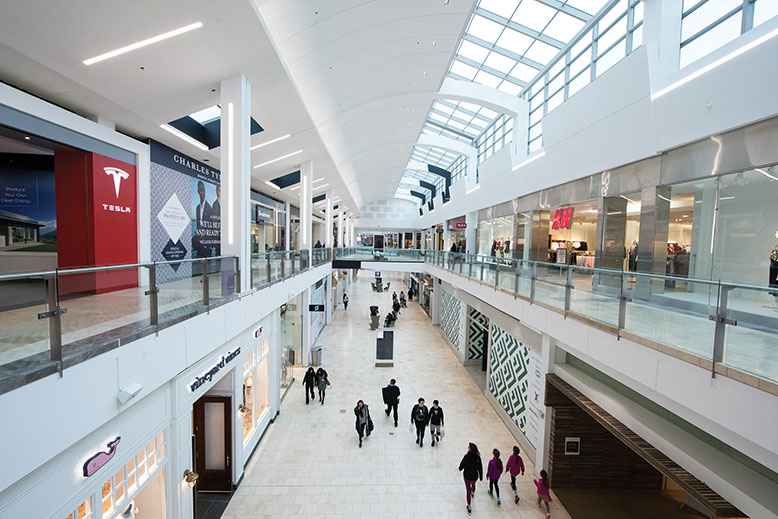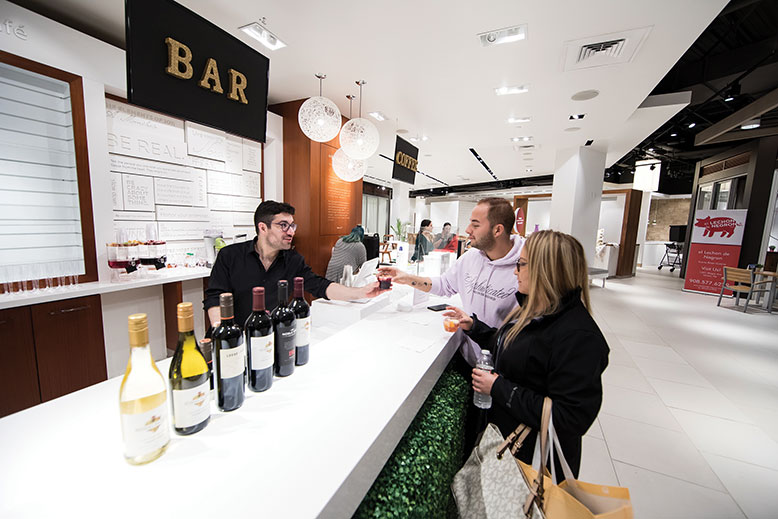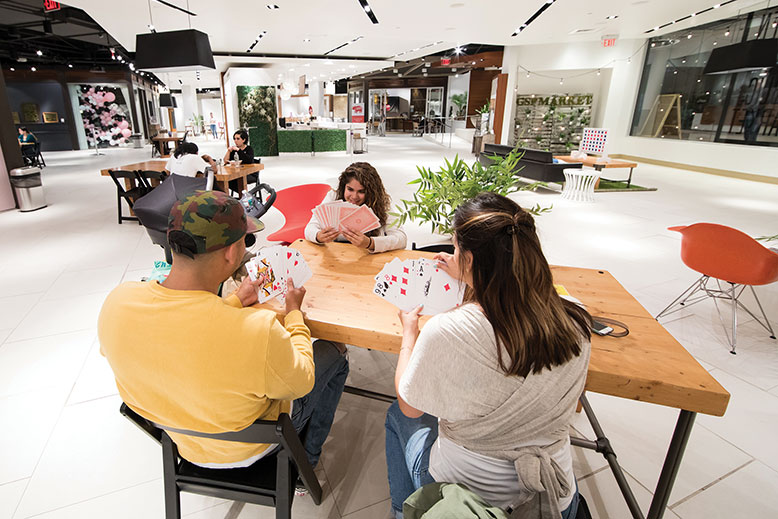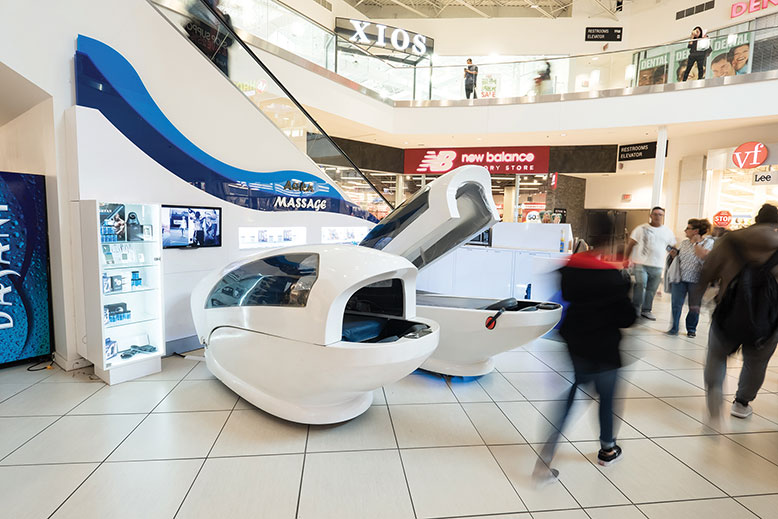
It’s lunchtime on a Tuesday, and there are no shoppers in sight at the Phillipsburg Mall. Just outside the entrance, a guy is smoking weed. Inside, the loudest sound is the echo of my own footsteps. In the distance, I detect the hum of the mall’s HVAC system.
No one is manning the customer service desk on this afternoon. The ice cream shop is dark—though its blackboard still advertises a “buy one cone, get one free” special. I turn a corner and a few shoppers come into view. A woman with a shopping bag enters a Hallmark Store, and a half-dozen customers browse the aisles of Old Navy. But apart from the cashier, I appear to be the only one in Kohl’s, one of just two anchor stores left in the mall following the closing earlier this year of Sears and Bon-Ton, a department store chain that is liquidating its 256 stores.
I try the wing housing Gold’s Gym, where a few fitness buffs can be seen catching a lunchtime workout. Nearby, nearly all the shops are shuttered. In fact, vacant shops seem to predominate throughout the 29-year-old mall, some behind metal gates, others still illuminated but eerily empty of merchandise.
The Phillipsburg Mall, in western Warren County, not far from where Route 78 crosses the Delaware River, is an extreme example, but throughout New Jersey, many malls are feeling a similar pain.
Online shopping and changing demographics have caused a seismic shift in traditional retailing that has left malls reeling. In some communities, malls are seeking to reinvent themselves as multidimensional destinations, with an increased emphasis on entertainment options and, in some cases, office space and residential units. For almost all malls, creating experiences has become as important as—or even more important than—shopping itself.
WHERE MALLS ARE HEADED
If you’re a Baby Boomer or a Gen Xer who came of age in the Garden State, a mall likely looms large in your memories. The mall was a place to hang out, to meet up with friends, to catch a bite at the food court, and to try on (and maybe even buy) the latest fashions. In winter, it was a little bit of summer even when snow whirled outside; in summer, it was cool and comfortable no matter how high the mercury rose. And when you grew up and had kids of your own, it was the place to go when you needed onesies, toddler fashions, and a place to escape the four walls of home. There was nothing else like it.
But times change. Today, there are some 1,200 enclosed malls across the United States, but that number is expected to shift dramatically downward. Last year, a report from the financial services company Credit Suisse predicted that up to a quarter of America’s malls could close within the next five years. Clearly, New Jersey is not immune. As of this writing, the state is down to 28 so-called enclosed regional malls (malls that draw shoppers from an entire region), following the closing earlier this year of the Burlington Center Mall in Burlington County.
In recent decades, New Jersey has lost the Flemington Mall and the Ledgewood Mall in Roxbury, both replaced by open-air shopping centers, and Seaview Square Mall in Ocean Township. Other malls remain in peril, and meet the definition of a “dead mall”—that is, one that is largely vacant and/or has lost its anchor tenants. Phillipsburg is arguably among those (management would not reveal its vacancy rate), as is Voorhees Town Center, which is suffering a 50 percent vacancy rate.
To be sure, a few malls in the state continue to thrive, notably the Mall at Short Hills, which is considered one of the most successful in the country, with sales per square foot a brisk $1,245 (SPSF is calculated as total revenue divided by total retail square footage). Westfield Garden State Plaza, with SPSF at $892, is similarly healthy. Still, they pale in comparison with the Mall at Rockingham Park in Salem, New Hampshire, perhaps the country’s most lucrative enclosed mall, with SPSF reported at $2,105.
Affluent communities with lots of buying power surround the Mall at Short Hills and Westfield Garden State Plaza, and both succeed in large part by catering to high-income shoppers in A-list stores like Gucci and Louis Vuitton. Unfortunately, not every mall is as well positioned. Voorhees Town Center, when it was sold in 2015, was earning a mere $241 SPSF.
APOCALYPSE NOW?
It’s widely believed that online shopping poses the greatest threat to New Jersey’s malls. Retail forecaster Forrester predicts that Web sales will constitute 11 percent of total U.S. retail this year, up from 8 percent in 2013. That doesn’t seem like a huge chunk, so why the dire predictions for malls?
James W. Hughes, dean emeritus of the Edward J. Bloustein School of Planning and Public Policy at Rutgers University and coauthor of New Jersey’s Postsuburban Economy, traces part of the problem to the transformation of department stores, which have long served malls as anchors—large stores expected to draw lots of shoppers. “Fifty years ago they were multifunctional,” Hughes says of department stores. “They sold household goods, furniture, apparel. Over time, though, they narrowed themselves to mostly apparel—and apparel is the largest online sector in absolute terms.”
In fact, according to a U.S. Census report, apparel represents 18 percent of the online market, followed by furniture and home furnishings at 10 percent.
Consider the large number of apparel retailers at almost any mall, and you start to understand the emergence of the term “retail apocalypse.” The coinage is used to describe the recent wave of retail bankruptcies (Bon-Ton, the Limited, Wet Seal) and store closings (Bebe, Michael Kors, J.C. Penney, Sears, Macy’s). The same Credit Suisse report that predicted all those mall closings also reported that a record 8,640 retailers would close up shop in 2017—40 percent more than in 2008, the first year of the Great Recession.
In addition to online competition, many stores are victims of what’s called over-retailing. This trend is seen in the emergence, a decade or so ago, of power centers. These convenient, open-air shopping centers—anchored by a big-box retailer like Target and incorporating a number of other large chain retailers—have become a significant shopping option. Often they mean not having to schlep to the mall for a pair of sneakers.
The retailing industry, says Hughes, “is cannibalistic. What we saw during the boom years was developers saying, ‘Okay, we know there’s not enough growth to support a new facility, but we’re going to build it anyway, because we’ll take this and that away from existing players.”
- The Garden State Plaza is among the state’s more successful malls.
- Joel Hernandez and Maria Saldana sample wine at a tasting bar inside Garden State Plaza’s pop-up Public Market.
- At the nearby Jerk Shack Grill, Edwin Sanchez, Jisele Fernandez and Andrea Bass play cards while awaiting their food orders.
- Aquamassage tables serve shoppers at Jersey Gardens in Elizabeth.
Photos by Ira L. Black
An additional threat to retail is financial. “Some retailers,” says Thomas Onder, a retail development attorney in Lawrenceville, “have just become too debt heavy.” In fact, many of the retailers that filed for Chapter 11 bankruptcy protection in the past two years—including mall standbys like Gymboree and True Religion—had previously been bought by private-equity firms that forced them to assume large amounts of debt. Other familiar brands, among them J.Crew and Claire’s, are reported to be working hard to manage potentially crippling debt loads.
Malls came of age with the Baby Boomers and their parents who, in the decades following World War II, fled the city and settled in the burgeoning suburbs. New Jersey’s first shopping mall was Garden State Plaza, which opened in three stages between 1957 and 1960, but wasn’t fully enclosed until 1983. The Cherry Hill Mall, which opened in 1961, was the first truly enclosed mall in New Jersey—and on the East Coast.
The malls lured shoppers from homes and drew vitality—and cash—away from town centers, often leaving local main streets with a shabby, desperate look. It worked until the millennials—the generation that came of age in the early years of the 21st century—decided they’d rather live in urban environments like Hoboken, Jersey City and Philadelphia, which offered easy access to all of the things they craved: bars, cafés, ethnic eateries, music clubs and the like. Malls began to lose not just a significant customer base, but also, in the words of Hughes, “their magic.”
SHARING THE PAIN

Zara Banite, left, of West Orange, and Faith Oluwadre, of Union, enjoy a shopping day at the Short Hills Mall, where high-end retailing continues to be the main attraction. Photo by Ira L. Black
When a mall deteriorates, retailers and mall operators suffer, but so, too, do the municipalities that depend on those malls for a significant portion of their tax revenue. Recently, towns like Burlington and Voorhees have considered extreme measures to deal with their dying malls. The Burlington Center officially closed in January, although its Sears anchor is still operating, at least for the time being. That leaves the town with an eyesore and a sputtering revenue engine. Over the past several years, Burlington’s municipal officials have been in conversations with the mall’s Las Vegas-based owner, Moonbeam Capital Investments, about redeveloping the 1.5 million square feet of retail space, but the talks haven’t yielded much in the way of results.
“We encouraged them to come to the township to request that the area be designated in need of redevelopment,” says Burlington Township mayor Brian Carlin. But that hasn’t happened, and the town is now losing shoppers to nearby Cherry Hill and Moorestown. Carlin expects Moonbeam to eventually file a tax appeal, arguing that the mall has lost value, and that could mean a further reduction in tax revenue for the town. There has been talk about seizing the mall through eminent domain, but that doesn’t sit well with Carlin. “Being a lawyer and respecting property rights,” he says, “I’d rather figure out a way to make it work without the intervention of eminent domain.”
Municipal officials in Voorhees are more actively considering the measure in order to seize the township’s flagging mall. Voorhees Town Center (previously known as the Echelon Mall) lost its Macy’s anchor in 2017. About half its retail space is vacant. Mario DiNatale, the township’s director of community and economic development, expects vacancies to rise, particularly since he believes current owners Namdar Realty Group and Mason Asset Management, both of Great Neck, New York, don’t appear to be interested in maintaining or modernizing the mall. “One of the escalators has been broken for four months,” he says. “In certain areas, the lights had been out for six months.”
“I don’t think the issue has ever been that we are not maintaining it,” responds Elliot Naseem, owner of Mason Asset Management. “Since we bought it, we’ve been trying to lease and redevelop it, with all options considered. Unfortunately, we haven’t been able to get traction as quickly as we’d anticipated.”
In May, the Voorhees Township committee adopted a redevelopment plan giving the town condemnation powers through eminent domain. “It gives us the ability to try to convince the existing owner to pay attention to the property a little bit better, or we’ll take it and sell it to somebody who will,” says DiNatale. He’s been in touch with several potential developers, one of whom proposed adding zip lines, a rock-climbing wall, indoor go-carts, and enhanced dining amenities, such as a microbrewery and wine-tasting spots. “Our apartments are full of millennials,” he says. “And rather than have to get on the train and go downtown, they could hang out at the mall if there was enough for them to do there.”
THE EXPERIENTIAL FUTURE
Giving millennials something to do is at the core of efforts to revitalize poorly performing malls and keep the high-performers booming. If they want to do their shopping online, the thinking goes, then draw them in with something the Internet can’t replicate—something experiential. That’s the buzzword among retail developers and analysts. Rather than relying on sales of shirts and running shoes, they say, the malls of tomorrow must sell experiences. It’s a big part of the thinking behind American Dream, the behemoth once again rumbling in the Meadowlands.
You can already see the experiential wave sweeping into New Jersey malls. Dave & Buster’s, the restaurant-cum-play-space, is moving into vacancies left by the closing, or partial closing, of former Sears stores—most recently at the Willowbrook Mall in Wayne. Gone are the circular saws and dishwashers once peddled by Sears. Instead, millennials can get buzzed on Zombie Snatcher and Star Wars Battle Pod.
Non-shopping experiences have always been a part of a trip to the mall, though they were often limited to the food court or draws for children, like the carousels at Woodbridge Center and Freehold Raceway Mall. Today, they’re more likely to involve the kind of games proffered at Dave & Buster’s or the adventures on tap at escape rooms like the Mystery Room at the Rockaway Townsquare mall, where you pay good money to enter a space and then find your way out.
Malls are also becoming venues for fitness centers, gyms and yoga studios, as well as outré experiences like cryotherapy, which involves getting really cold for a brief period of time in order to treat conditions like insomnia and arthritis.
“One of the most active retail categories out there right now is health, wellness and fitness,” says David Townes, senior director for retail brokerage at Cushman & Wakefield in East Rutherford. “They’re very attractive tenants for all kinds of owners, from enclosed malls to neighborhood shopping centers.”
Urgent-care centers are another attractive tenant for mall operators. “People are looking for convenience in their daily lives,” says Onder, “and malls are seeing that this is a positive for them, because it will bring people in and then keep them there to do their shopping.”
Malls also are increasingly welcoming temporary, pop-up experiences, like the Public Market at Garden State Plaza, a collection of artisanal-food sellers that opened—and closed—this spring and included jazz performances and trapeze-fitness demonstrations.
On one April afternoon, Nick Gonzalez and Darrel McDowell, both 17, were hanging out at the Market after school, enticed by the Puerto Rican cuisine at El Lechon de Negron, a pop-up incarnation of an eatery located year-round in Union. A few tables away, Jisele Fernandez, Edwin Sanchez and Andrea Bass were playing cards with an oversize deck—one of several games scattered around the Market—while waiting for their order from the Jerk Shack Grill. “We come to the mall a lot,” Bass noted. “It has everything.”
Another mall, Rockaway Townsquare, recently obtained a use variance from Rockaway Township to allow the Water Circus, a Cirque-du-Soleil-type extravaganza, to perform for a week in the mall’s parking lot. Jason Rittie, a real estate lawyer in Denville, who helped secure the variance, says municipalities generally welcome pop-up events “because they want to still have these malls as vibrant taxpayers.”
Rittie also worked with Rockaway Township to change the local zoning to allow open-air restaurant seating at Rockaway Townsquare, a trend he sees in other malls as they try to cash in on America’s appetite for foodie experiences.
Indeed, trendy eateries are turning up in mall locations where Cinnabon and Nathan’s once reigned. These include Iron Chef Jose Garces’s Distrito, which opened in 2014 in the Moorestown Mall, and Bobby’s Burger Palace, operated by celebrity chef Bobby Flay, which has three New Jersey mall locations, including Princeton’s Marketfair Mall.
“Marketfair has been completely redesigned to have more food accommodations,” says Onder. These include the wine bar and grill Seasons 52, the Caribbean restaurant Bahama Breeze, and the upscale, down-home Corner Bakery Cafe. The hope, says Onder, is that “if you go there for lunch or dinner, you’re most likely going to walk out in the mall and do some type of shopping.”
Joseph F. Coradino, CEO of Pennsylvania Real Estate Investment Trust (commonly known as PREIT), the owner of 21 U.S. malls, including Cherry Hill and Moorestown, notes that 75 percent of the company’s newest leases represent “the new mall experience,” including health and wellness, dining and entertainment.
Other burgeoning categories include off-price shopping (exemplified by high-end outlet mall Jersey Gardens in Elizabeth) and fast fashion. In the latter category, retailers like Zara and Topshop scoop up trends from the catwalk and rapidly transform them for the everyday consumer.
ANCHORS AWEIGH
With several department store chains in trouble, some mall operators are rethinking the concept of anchors. Onder says anchors are typically given advantageous lease rates because they presumably draw shoppers into the mall. Now, some operators are slicing and dicing former anchor spaces and pulling in much higher rental rates.
To that end, PREIT opened 10 tenants in five former department store spaces last year, says Coradino. This year, they’ll open seven tenants in four former anchor spaces, and in 2019, they plan to open at least 10 different tenants in three spaces previously taken up by anchors.
Still, even smart mall operators may not be able to save what Hughes calls the “dispersed malls,” situated in places such as Sussex, Warren and Hunterdon counties, where populations have begun to stagnate. Malls in such zones, he believes, will be demolished. Others, like Bridgewater Commons and Quaker Bridge in Lawrence Township, between Princeton and Trenton, may have to reinvent themselves as something other than enclosed malls.
That’s exactly what’s being proposed for the Monmouth Mall in Eatontown by its current owners, Kushner Companies, the New York-based real estate operation owned by the family of Donald Trump’s son-in-law, Jared Kushner, and Rouse Properties, a fellow New York-based developer. This spring, the companies presented a plan to redevelop the mall as the Heights at Monmouth. They envision a mix of retail, entertainment, medical, high-end dining and residential spaces. The project has generated a fair amount of controversy—and a pending lawsuit—mostly for its housing component, which some residents fear could burden schools and other municipal services.
Still, Hughes credits the plan “for being ahead of the game in terms of trying to create a 24/7 community attractive to millennials and the like.”
A similar residential/retail development called Riverton has been proposed for Sayreville, where plans for an enclosed mall were recently ditched. As envisioned, the waterfront development would include a marina with indoor/outdoor dining options, low-rise buildings with shops on the ground floor and apartments above, some stand-alone big-box stores, and perhaps small venues for concerts and other forms of entertainment. The Ohio-based developer, North American Properties in partnership with Jersey-based Sayreville Seaport Associates, would be required to assume some of the cost for burdens to the school system; the figure being discussed is $19 million. Joseph Ambrosio, executive director of Sayreville’s economic redevelopment agency, says the project would have “a huge impact on the community in terms of tax revenue and employment.”
If the planned development sounds familiar, it should. Riverton and similar developments—walkable, with a residential/retail mix and a range of amenities, from entertainment to medical care—are essentially old-fashioned towns. In fact, we may well be coming full circle, from a time when enclosed malls pulled shoppers away from traditional downtowns to an era when downtowns regain their luster. Some of those downtowns might even be in repurposed malls.
Correspondent Leslie Garisto Pfaff moved to New Jersey in 1988 and admits that, since then, she’s wasted more than a few hours in the state’s shopping malls.




